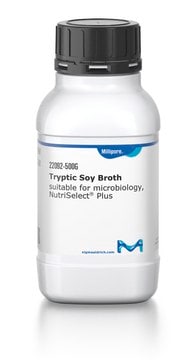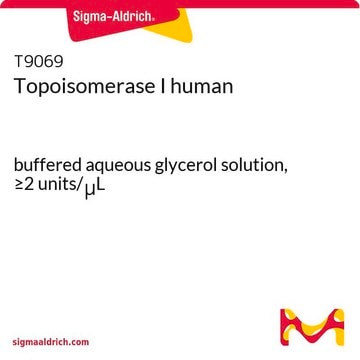KEM0032
Terminal deoxynucleotidyl Transferase (TdT)
Ultra-pure enzyme for nucleic acid modifications
Iniciar sesiónpara Ver la Fijación de precios por contrato y de la organización
About This Item
Productos recomendados
grado
for molecular biology
Ensayo
>99% (SDS-PAGE)
Formulario
buffered aqueous solution
actividad específica
27,400 U/mg
concentración
20,000 U/mL
Condiciones de envío
dry ice
temp. de almacenamiento
−20°C
Descripción general
Terminal deoxynucleotidyl transferase (TdT) is a template-independent DNA polymerase that catalyzes the addition of deoxynucleotides to the 3′ hydroxyl terminus of single or double stranded DNA molecules. The presence of 1 mM Co2+ stimulates the tailing of the 3′-ends of DNA fragments. This construct is sold as an N-terminal truncation of the terminal transferase gene attached to an N-terminal fusion tag.
Aplicación
Suitable for:
- Homopolymeric tailing to the 3′ OH
- TUNEL assay
- 5′-RACE
- Labeling of 3′ ends
Características y beneficios
- Ultra-purification process for ultimate enzyme performance
- Highest quality specifications for ultimate product consistency
- Undetectable DNA and nuclease contamination
Componentes
Supplied with:KEM0043B (10X Green Buffer)KEM0045B (2.5 mM CoCl2
Definición de unidad
1 unit is defined as the amount of polymerase required to convert 1 nmol of dTTPs into acid insoluble material in 1 hour at 37° C.
Forma física
Supplied in 50 mM KPO4, 100 mM NaCl, 1.0 mM DTT, 0.1 mM EDTA, 0.1% Triton™ X-100, and 50% glycerol at pH 7.3 @ 25° C.
Otras notas
Source of protein: An E. coli strain that carries the cloned terminal transferase gene from calf thymus.
Unit size: 6,000 U
Información legal
Triton is a trademark of The Dow Chemical Company or an affiliated company of Dow
Producto relacionado
Referencia del producto
Descripción
Precios
Palabra de señalización
Danger
Frases de peligro
Consejos de prudencia
Clasificaciones de peligro
Aquatic Chronic 3 - Carc. 1B
Código de clase de almacenamiento
6.1C - Combustible acute toxic Cat.3 / toxic compounds or compounds which causing chronic effects
Elija entre una de las versiones más recientes:
¿Ya tiene este producto?
Encuentre la documentación para los productos que ha comprado recientemente en la Biblioteca de documentos.
Laure Rittié et al.
Journal of cell communication and signaling, 2(1-2), 25-45 (2008-09-04)
Since molecular cloning has become routine laboratory technique, manufacturers offer countless sources of enzymes to generate and manipulate nucleic acids. Thus, selecting the appropriate enzyme for a specific task may seem difficult to the novice. This review aims at providing
Nuestro equipo de científicos tiene experiencia en todas las áreas de investigación: Ciencias de la vida, Ciencia de los materiales, Síntesis química, Cromatografía, Analítica y muchas otras.
Póngase en contacto con el Servicio técnico








